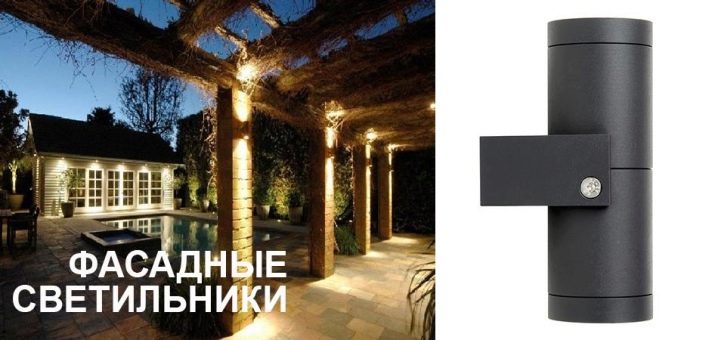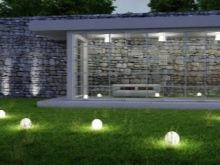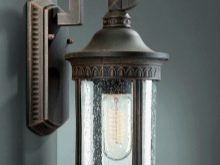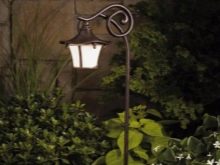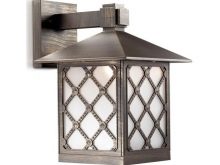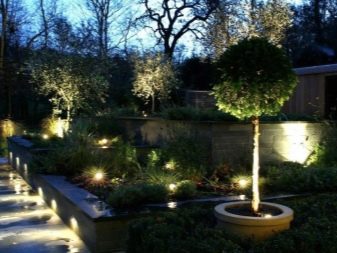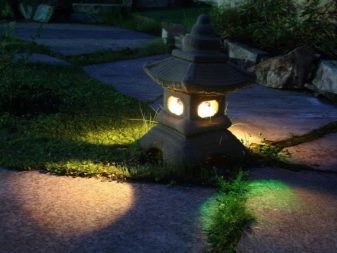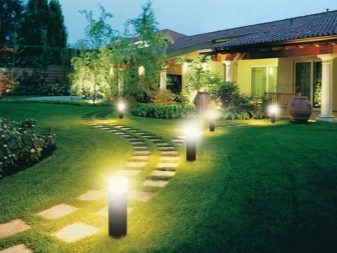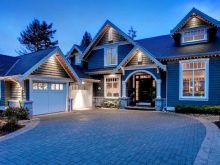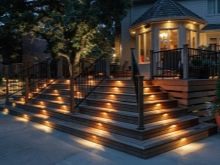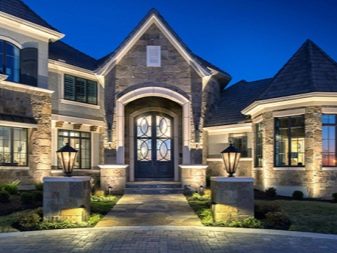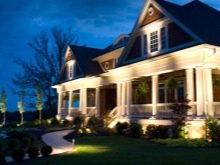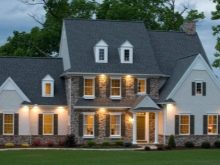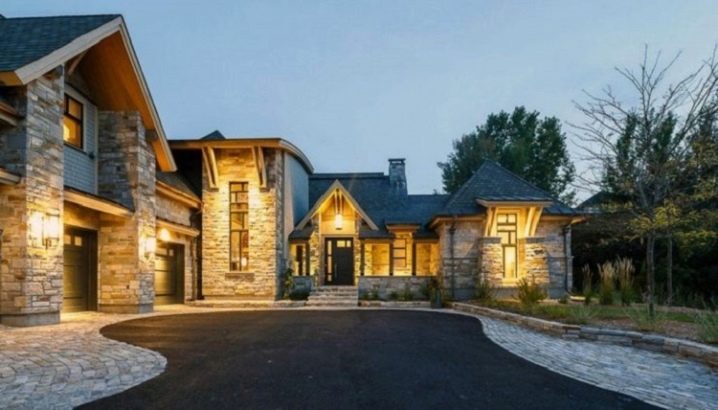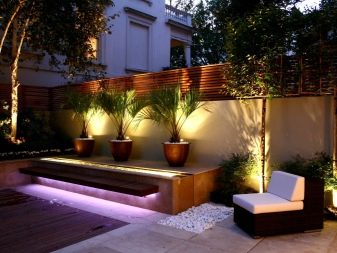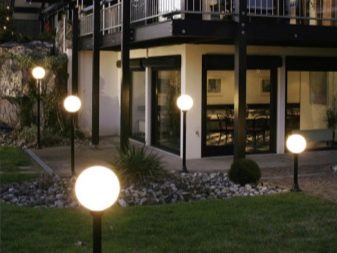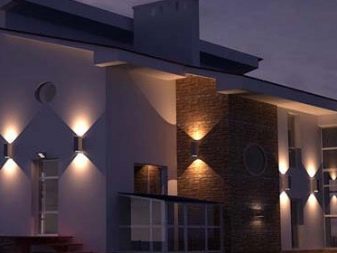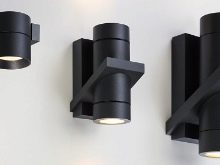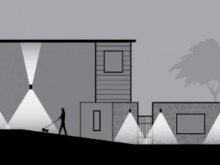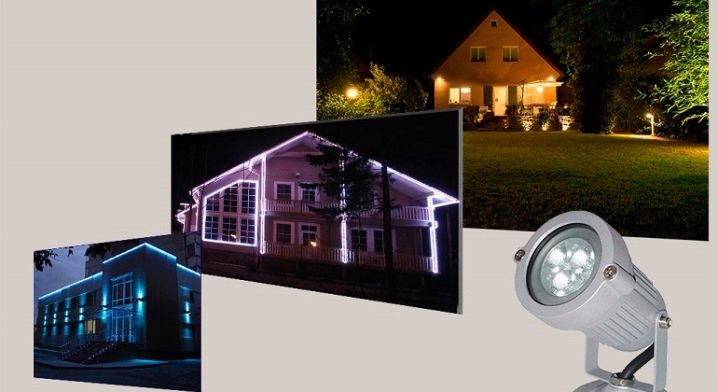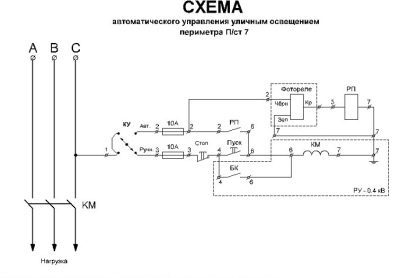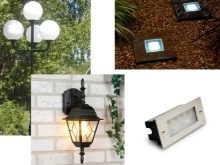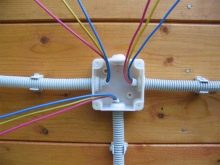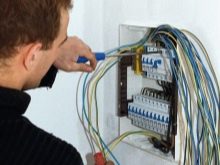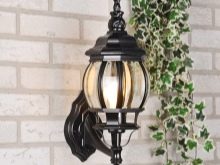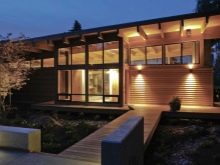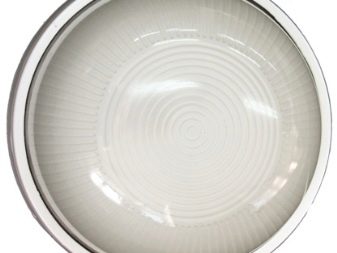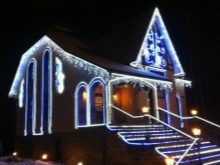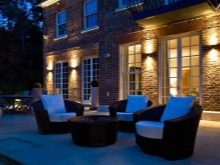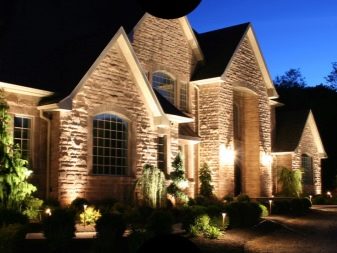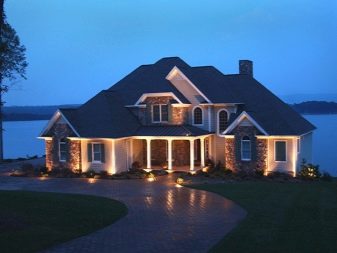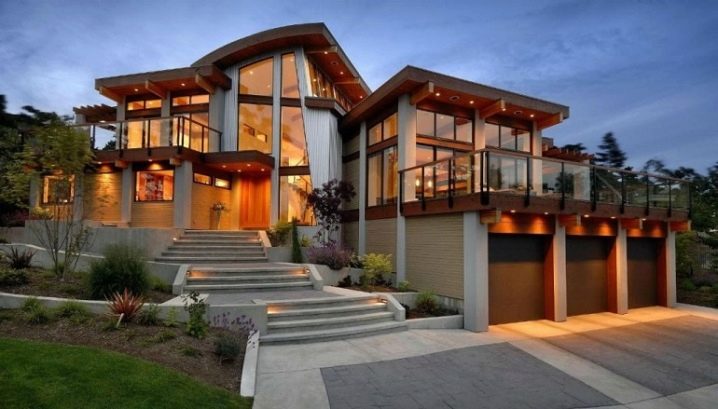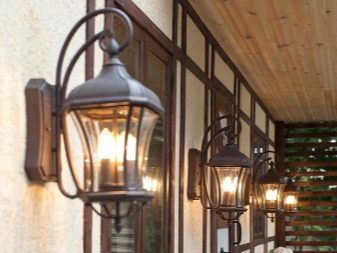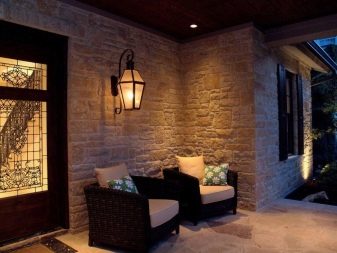Front lights: the choice of architectural lighting for the building
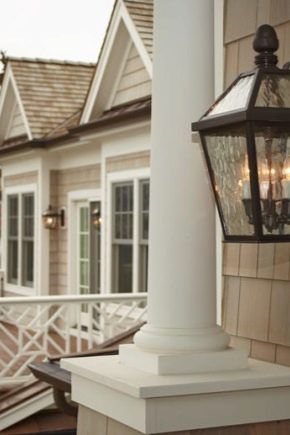
Modern landscape design is impossible without lighting. Facade lamps are the best method of architectural lighting of the building. They are functional and feature a wide range of designs. This makes them popular with buyers and professional designers.
Special features
Facade luminaires are street appliances, which are used to illuminate the house outside and near the house. Depending on the types, they can be multifunctional and differ in the principle of operation. In priority devices that emphasize a certain style of the interior, while highlighting the desired area in the required amount. In addition, they should look harmonious in landscape design.
These are lamps and devices that attach to the walls and roof. Such devices include ground and suspended type lights. A feature of modern lighting is the use of RGB class lighting. It allows you to bring a touch of originality and diversity, replacing the traditional glow color.
This lighting looks unusual and elegant. If desired, you can change the shade of the light flux.
Kinds
All existing varieties of such devices can be divided into devices for floodlighting, local and hidden illumination.
- Spotlights They are halogen or LED models with bright and directional luminous flux. By the type of location they are panoramic and angular.
- Embedded varieties are wall mounted. sconce in the form of lanterns.
- Floor items belong to the class of bilateral lamps. These wall lamps are functional and suitable for illuminating entrance groups, house territories, as well as signage plates.They can be used to fill the main space with light, in the design of a veranda or terrace, and to illuminate small sections of the facade.
Such type provides difficult installation and service. With the help of these models, you can effectively emphasize a certain style of landscape design. These include forged lights or analogues with closed covers and grilles.
In addition to these varieties, popular options are products of the linear or tape type. These are special LED diode lamps in the form of a flexible tape. Illumination with LED strip allows you to identify architectural elements, highlight the contours of the roof, create an interesting pattern. It can be hidden behind the eaves, stucco, elements of the entrance group.
Ground varieties are attached near the building. More often the basis becomes the concrete basis, a tile or asphalt. Such models are protected from moisture and accidental mechanical damage. During installation, you can give them the desired angle of inclination of the light flux. This allows you to create a special light composition. Illumination sources can have a different shape (from retro and classic models of luminaires to ultramodern innovations or items in the form of figures, as well as overhead counterparts).
Projects for a private house
In addition to the local, hidden and flood view, the luminous flux can be contour, artistic and architectural. Stylists can offer the client design in the form of color dynamics, allowing to play with the effects of light shadows, change the strength, temperature and shade of the flow of light. Someone will like neon or laser lights. Others will like elegant New Year decoration.
In any case, the issue of lighting the building and the local area is approached thoroughly at the design stage of the building. Exterior should look bright and modern. To do this, you can use spotlights or spot placement of lamps on the facade.
In the first case, the project envisages flooded facade lighting. In the second, the backlighting is artistic.
With its help, you can identify features of the architectural elements of the building. For example, it is possible to accentuate the ledges of columns with external illumination, to illuminate the space above the windows around the perimeter of the cottage. In this case, the best project will be the option of using a combined backlight. For example, walls can be designated with downlight lamps with the ability to adjust the angle of inclination. The contour of the roof can be distinguished by a flexible LED strip.
LEDs look good with neon devices. A good option would be to combine bollards, strobe and colored illumination. For the blind area of the house and the porch it is better to choose lamps of distributed light. The basic rule of harmony is the compatibility of all light sources between themselves and the general concept of landscape composition.
To make architectural exterior lighting appropriate, avoid using long brackets.
Such products spoil the design, so today they are extremely rare in projects for lighting the facade. Regardless of the type and number of devices used, the project provides for compliance with energy consumption standards, cost-effectiveness, convenience and safety of the used facade lighting.
How to organize yourself?
In fact, the creation of facade lighting is not a difficult process with proper preparation. After creating a drawing with markup, they buy the necessary lamps and components, assemble them, according to the project.
Calculation of materials and components
The choice of lighting devices depends on the design features of the facade.Lamps can have a flat and curvilinear shape, inclined glazing, etc. When you combine lamps in groups, they are repelled by the characteristics of their placement. To the level of illumination was optimal, make preliminary calculations.
If you ignore this aspect, the light can be dim or too bright, annoying eyes. To do this, take into account the power, purpose of the equipment, the type of fixture of the lamps and the method of their installation.
If necessary, the use of ribbon illumination measure the length of the contour, which is planned to illuminate and add a small allowance. It is necessary for cutting in specially designated areas. After the calculations, choose a tape with the desired density, number of rows, the power of the diodes and buy it with a solid cut.
The number of wall fixtures depends on the locations of the wiring and the installation possibilities. Usually there are bilateral artistically decorated devices at the entrance.
Types and number of components (accessories) for assembly depend on the model. It can be chains, cartridges, wires, fasteners, tubes, bowls, cases for cartridges, earrings, straps, glasses.They are selected along with the main devices. The wire for the power supply is taken with a margin.
To accurately find the desired number of lamps and related materials, you can use special design programs. However, in fact, it is easier to walk around the site, inspect where and how the lamps will be located.
After determining their number, proceed to measuring the distance from each other and the power source. This will give a more real picture. Lamps easier to buy immediately with a complete set.
Schemes and drawings
Making the scheme, it is necessary to consider the size of the illuminated space. However, it should not intersect with architectural elements (sheds, peaks). Take into account the structural features of the structure, the availability of electricity and voltage, based on the possibilities of the budget. The main power source, according to the scheme, is the input-distribution device.
Electric lighting of the facade is carried out by means of a power cable equipped with PVC insulation. The outdoor lighting cable is laid on refractory building structures.Produce grounding and lightning protection measures.
The most economical outdoor lighting scheme is a project with a time relay. It can save up to 40% of electricity, since it is turned off at night.
For its implementation using a two-channel astronomical relay PCZ-527, photo relay with sensor, circuit breakers and a contactor. The contactor is used to switch the load, it controls the relay and photocell. The scheme often includes a timer that is configured for different work lights. If desired, the control can be manual.
How to connect?
After the project is created, the lamps and all the equipment are purchased, you can proceed to the installation of the lighting system. To do this, use a ready-made design scheme. Lamps are placed on it, fixed in the right places. The location depends on the choice of lighting, as well as the method of installation. In the case of background placement, it is necessary to maintain a distance of at least 30 cm from the main structure.
If it is necessary to perform floodlighting, the lighting devices are installed at the highest point of the local area. After the lamps are installed in their places, cable lines in a corrugated or metal pipe are brought to them. Packaging in corrugated sleeves will ensure reliable and safe operation of electrical wiring. Wiring carry out cable in rubber insulation.
If it is impossible to hold the wire in a special channel, it is thrown through the air at a height of at least 3 m above the garden paths. Light devices should not fall into the windows of neighbors. The intersection of streams with nearby lamps is excluded. For this reason it is necessary to remove them from each other. The switches are located in places closed from precipitation.
It is advisable to use copper wires, as they are less susceptible to mechanical stress. Perform grounding of each lamp. Triple cable is used for the underground line.
When laying pipes, PE protects the wire from damage by making the substrate beneath it of fine gravel or sand 10 cm thick. A signal tape is laid in the trench. In case of random digging, it will indicate the location of the wiring.
Professional Tips
When arranging the lighting of the facade can be useful recommendations of experienced craftsmen in the field of construction and repair. For example, lighting devices for architectural lighting of the frontal part of the building must:
- be safe to use;
- have weather protection;
- to combine decorative and lighting functions;
- be more energy efficient;
- be easy to install and operate.
The location of the facade lamps can be symmetrical. Clear contours give cool light tones. For the illusion of a close location of the object is better to use lamps with a warm stream of light. In the design should not be more than three different color shades of light.
In addition, you can take into account a few more nuances:
- for lighting the building it is preferable to buy lamps with an IP65 mark;
- the instrument case must be aluminum;
- copper and aluminum wires must not be connected;
- when choosing LED lighting, it is better to conduct power through a transformer;
- for greater light effect, the light should fall from bottom to top;
- it is better to beat voids and drops by using color illumination using a flood light;
- if you do not want to buy lamps made of aluminum, you can look at the analogs of polycarbonate or acrylic;
- A sign with the house number and street name is illuminated separately by means of the lamp in the same style with all the lighting devices.
Spectacular examples in the exterior
Evaluate the possibilities of lighting the facade will help examples of the photo gallery.
- Architectural lighting of a country house. Selection of the facade and the entrance group. The use of lanterns and spotlights.
- Accepting the contour of the house. The use of flexible LED strip allows you to identify the roof and window elements.
- The use of point illumination around the perimeter under the roof and in places of constructive projections.
- Wall lanterns with forged elements and closed glass shades add a special touch to the design of the facade.
- Decorating the seating area of an open veranda with a lantern makes the atmosphere special. The lamp harmoniously looks on the background of stonework and wicker furniture.
In the next video you will find a presentation of Novotech facade lamps.
